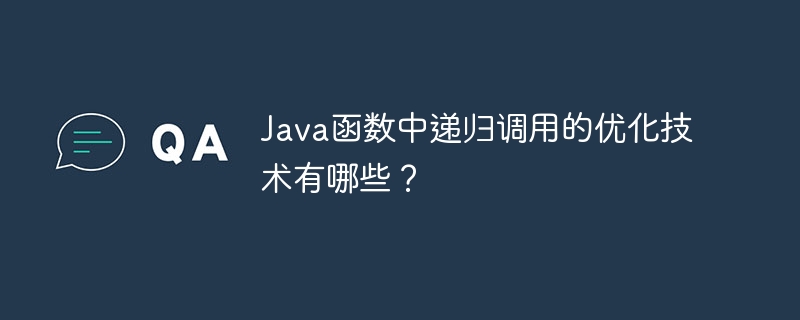
Techniques for optimizing recursive calls: Tail recursion elimination: Convert tail recursion into a loop and eliminate stack overflow. Iteration instead of recursion: Use loops instead of recursion to save the cost of function calls. Memo: Stores previous calculation results to reduce the number of recursive calls.

Optimization Techniques for Recursive Calls in Java Functions
Recursion is a powerful programming technique that allows functions to call themselves. However, recursion can cause stack overflow, especially when function calls are too deep or when the data set being processed is too large. In order to optimize recursive calls, we can use the following techniques:
1. Tail recursion elimination
Tail recursion means that the function calls itself in the last step. The Java Virtual Machine can optimize tail recursions by converting them into loops, thereby avoiding stack overflows.
public static int factorial(int n) { if (n == 0) { return 1; } else { return n * factorial(n - 1); // 尾递归调用 } }
2. Use iteration instead of recursion
In some cases, we can use an explicit loop instead of recursion. This saves the overhead of function calls and prevents stack overflows.
public static int factorial(int n) { int result = 1; for (int i = 1; i <= n; i++) { result *= i; } return result; }
3. Memo
Memo is a technique used to store previously calculated results. When the function calls itself again, it first checks whether the result exists in the memo. If it exists, the result is returned directly, otherwise a recursive call is made.
import java.util.HashMap; import java.util.Map; public static int factorial(int n) { Map memo = new HashMap<>(); return factorial(n, memo); } private static int factorial(int n, Map memo) { if (n == 0) { return 1; } else if (memo.containsKey(n)) { return memo.get(n); } else { int result = n * factorial(n - 1); memo.put(n, result); return result; } }
Practical case
Consider a recursive function that calculates the Fibonacci sequence:
public static int fibonacci(int n) { if (n <= 1) { return n; } else { return fibonacci(n - 1) + fibonacci(n - 2); // 递归调用 } }
For largernvalue, this function may cause a stack overflow. We can optimize it using tail recursion elimination:
public static int fibonacci(int n) { return fibonacci(n, 0, 1); } private static int fibonacci(int n, int prev, int current) { if (n == 0) { return prev; } else if (n == 1) { return current; } else { return fibonacci(n - 1, current, prev + current); // 尾递归调用 } }
The above is the detailed content of What are the optimization techniques for recursive calls in Java functions?. For more information, please follow other related articles on the PHP Chinese website!
